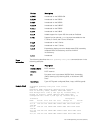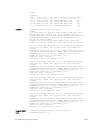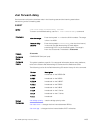
NOTE: A port configured as an edge port, on a PVST switch, immediately
transitions to the forwarding state. Only ports connected to end-hosts should
be configured as an edge port. Consider an edge port similar to a port with a
spanning-tree portfast enabled.
If you do not enable shutdown-on-violation, BPDUs are still sent to the route
process module (RPM) CPU.
You cannot enable root guard and loop guard at the same time on a port. For
example, if you configure
loop guard on a port on which root guard is already
configured, the following error message is displayed: % Error: RootGuard is
configured. Cannot configure LoopGuard
.
When used in a PVST+ network, loop guard is performed per-port or per-port
channel at a VLAN level. If no BPDUs are received on a VLAN interface, the port or
port-channel transitions to a Loop-Inconsistent (blocking) state only for this VLAN.
Enabling Portfast BPDU guard and loop guard at the same time on a port results in
a port that remains in a Blocking state and prevents traffic from flowing through it.
For example, when Portfast BPDU guard and loop guard are both configured:
• If a BPDU is received from a remote device, BPDU guard places the port in an
Err-Disabled Blocking state and no traffic is forwarded on the port.
• If no BPDU is received from a remote device, loop guard places the port in a
Loop-Inconsistent Blocking state and no traffic is forwarded on the port.
Example
Dell(conf-if-te-1/1)#spanning-tree pvst vlan 3 cost 1800
Dell(conf-if-te-1/1)#end
Dell(conf-if-te-1/1)#show config
!
interface TenGigabitEthernet 1/1
no ip address
switchport
spanning-tree pvst vlan 3 cost 1800
no shutdown
Dell(conf-if-te-1/1)#end
Dell#
Related
Commands
show spanning-tree pvst — views the PVST+ configuration.
Per-VLAN Spanning Tree Plus (PVST+)
1451


















